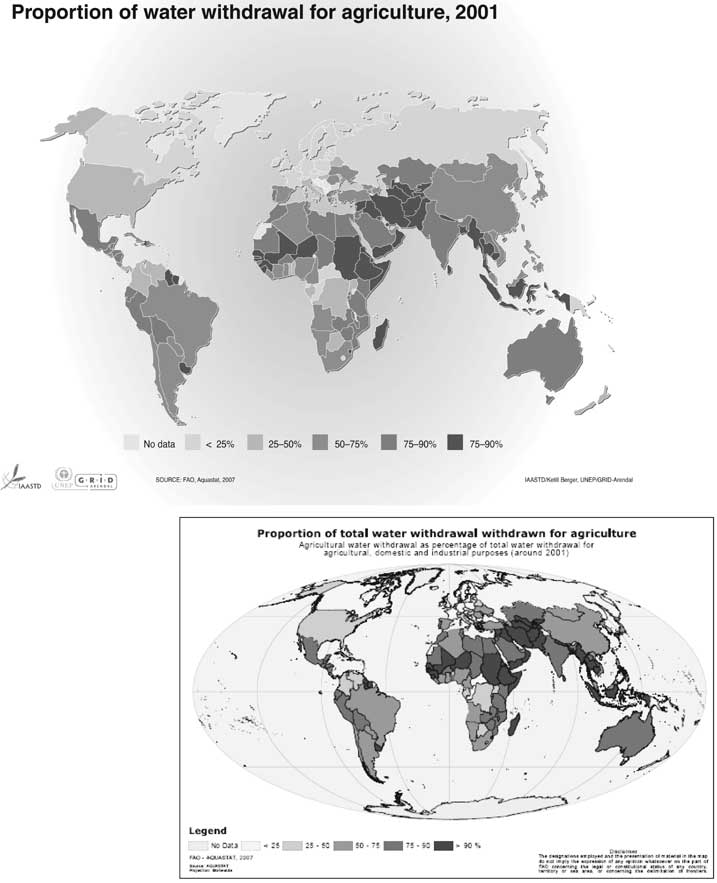
Figure 3-4. Agricultural water withdrawal as percentage of total water withdrawal for agricultural, domestic and industrial purposes worldwide. Source: FAO AQUASTAT, 2007.
from 17 kg in 1971 to 12 kg in 2003 (Ali et al., 2005). Recently, however, vegetable production has increased in developing countries, through public-private collaboration in the introduction of modern varieties and technologies. The replacement of traditional plant based diets with increased consumption of more energy-dense, nutrient-poor foods with high levels of sugar and saturated fats in all world regions (Popkin, 2003) has been driven by increased incomes and other factors such as changes in food availability, and retail and marketing activities. Increased protein consumption (e.g., meat and dairy products) is occurring in developing countries, but high costs limit consumption primarily to the urban elite.
The application of modern AKST has led to a decline in the availability and consumption of traditional foods.
Goals |
Certainty |
Range of Impacts |
Scale |
Specificity |
In the past, many traditional foods were gathered from forests and woodlands, which provided rural households with food and nutritional security. With the loss of habitat through deforestation, population growth, increased urbanization and poverty and an emphasis on staple food cultivation, this wild resource has diminished. In addition, improved access to other food crops and purchased foods (Arnold and Ruiz Pérez, 1998) have contributed to the trend towards diet simplification, reduced fresh food supply, and disappearance of nutrient rich indigenous food. This simplification has had negative impacts on food diversity and security, nutritional balance, and health. Indigenous fruits and vegetables have been given low priority by policy makers, although they are still an important component of diets, especially in Africa.
Supplies of nutritious traditional food are in decline, but reversible.
Goals |
Certainty |
Range of Impacts |
Scale |
Specificity |
Deforestation and increasing pressures from urban infrastructure have reduced the fresh sources of food supply from forests and urban gardens (Ali et al., 2006). Projects to reverse this trend promote traditional foods as new crop plants (Leakey, 1999a; Leakey et al., 2005a) and encourage their consumption. For example in Zambia, the FAO Integrated Support to Sustainable Development and Food Security Program (IP-Zambia) is promoting the consumption of traditional foods (www.fao.org/sd/ip).
3.2.1.2 Biotechnology: conventional breeding and tissue culture
The modification of plants and animals through domestication and conventional plant breeding (i.e., excluding use of nucleic acid technologies and genetic engineering) has made a huge contribution to food production globally: the Green Revolution for plants, the Blue Revolution for fish and the Livestock Revolution.
3.2.1.2.1 Impact of modern varieties of crops (including trees) and improved livestock breeds
The impact of domestication and conventional breeding, especially in annual crop plants, has been well documented. Modern varieties and breeds have had positive impacts on yield and production, especially where environments have been favorable and management has been good. However, there have also been some negative effects on the environment and on biodiversity. There is also some concern that on-station and on-farm yields are stagnating.
Agriculture is dependent on very few species of animals and plants.
Goals |
Certainty |
Range of Impacts |
Scale |
Specificity |
Agriculture began with the domestication of wild animals and plants. About 1000 plant species have been domesticated resulting in over 100 food and 30 non-food crops (fiber, fodder, oil, latex, etc., excluding timber). Approximately 0.3% of the species in the plant kingdom have been domesticated for agricultural purposes (Simmonds, 1976) and 4.1% for garden plants (Bricknell, 1996). These proportions rise to 0.5 and 6.5% respectively if limited to the higher plants (angiosperms, gymnosperms and pteridophytes) of which there are some 250,000 species (Wilson, 1992), but are small when compared with the 20,000 edible species used by hunter-gatherers (Kunin and Lawton, 1996). A similar pattern has occurred in animals and fish, with only a small proportion of the species traditionally consumed domesticated through AKST. Over the last 50-60 years plant and animal breeding was a major component of the Green Revolution.